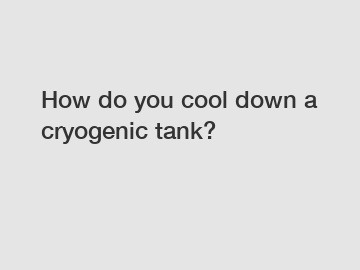Dec. 25, 2023
Machinery
How Do You Cool Down a Cryogenic Tank?
Cryogenic tanks are essential for storing substances at extremely low temperatures. These tanks are commonly used in various industries, including healthcare, aerospace, and energy. However, to maintain the substances in their liquid state, the cryogenic tanks must be kept at severely low temperatures. This begs the question: how do you cool down a cryogenic tank? In this article, we will explore the methods used to cool these tanks and ensure their efficiency.
1. Understanding Cryogenic Tank Cooling.

Cryogenic tanks store substances, such as liquid nitrogen, liquid oxygen, or liquefied natural gas (LNG), at extremely low temperatures ranging from -196°C to -270°C (-321°F to -452°F). To keep these substances in their liquid state, the tanks must maintain a consistent internal temperature significantly below their boiling points. Achieving and maintaining these low temperatures can be challenging but is crucial for the preservation of the stored substance.
2. Passive Cooling.
One common method of cooling a cryogenic tank is through passive cooling systems. These systems rely on the natural process of heat transfer, where heat moves from a warmer object to a colder one. In a passive cooling system, the cryogenic tank is placed inside a thermally insulated vessel, known as a vacuum jacket. The vacuum between the tank and the jacket minimizes heat transfer by creating a barrier between the tank and the surrounding environment.
The passive cooling system ensures that there is minimal heat leakage into the tank, allowing the stored substance to remain at a low temperature. However, passive cooling systems are limited in their ability to cool the tank actively. Therefore, additional cooling methods are often required to achieve and maintain the desired temperature.
Further reading:3. Active Cooling.
To actively cool a cryogenic tank, various cooling methods can be employed. One common method is the use of a cryocooler, a device that uses a compression and expansion process to cool the tank. Cryocoolers utilize refrigeration cycles, where a refrigerant gas is compressed, cooled, expanded, and then re-cooled in a continuous loop. This process creates a cooling effect, lowering the temperature of the tank and the stored substance.
Another active cooling method is the use of liquid nitrogen or liquid helium. These cryogens are extremely cold and can be used to cool the tank. By circulating liquid nitrogen or helium around the tank, heat is transferred from the tank to the cryogen, effectively cooling it. This method is often used in applications where a constant supply of cryogens is available.
4. Monitoring and Maintenance.
Regardless of the cooling method employed, monitoring and maintenance are crucial to ensure the optimal performance of cryogenic tanks. Regular inspections, leak detection systems, and pressure monitoring are essential for both efficiency and safety. Any heat leakage or fluctuation in temperature should be promptly addressed to prevent damage to the tank or the substance stored within it.
In conclusion, cooling a cryogenic tank requires specific methods to maintain the substances in their liquid state. Passive cooling systems, such as vacuum jackets, minimize heat transfer, while active cooling methods, like cryocoolers or circulating cryogens, actively lower the tank's temperature. Regular monitoring and maintenance are vital to ensure the tanks' efficiency and safety.
If you have any further questions or require assistance with cooling cryogenic tanks, please do not hesitate to contact us. Our experienced team is ready to provide the expertise needed to meet your cooling requirements effectively.
The company is the world’s best Low-Temperature Liquid Oxygen Micro Bulk Storage Tank, Liquid Carbon Dioxide Micro Bulk Storage Tank, Liquid Oxygen Micro Bulk Storage Tank supplier. We are your one-stop shop for all needs. Our staff are highly-specialized and will help you find the product you need.
Further reading:Related Articles
If you are interested in sending in a Guest Blogger Submission,welcome to write for us!
All Comments ( 0 )